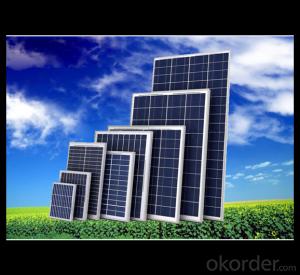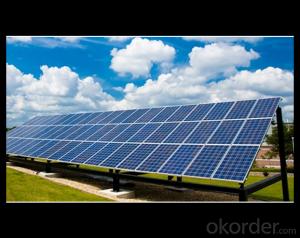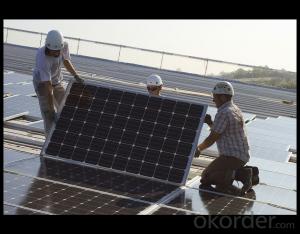20W Direct Factory Sale Price 260-300Watt Solar Panels
- Loading Port:
- China main port
- Payment Terms:
- TT OR LC
- Min Order Qty:
- 10000 watt
- Supply Capability:
- 100000 watt/month
OKorder Service Pledge
OKorder Financial Service
You Might Also Like
Item specifice
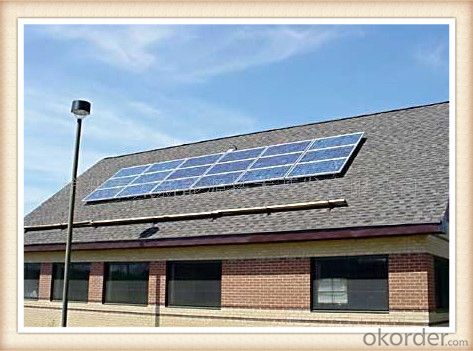
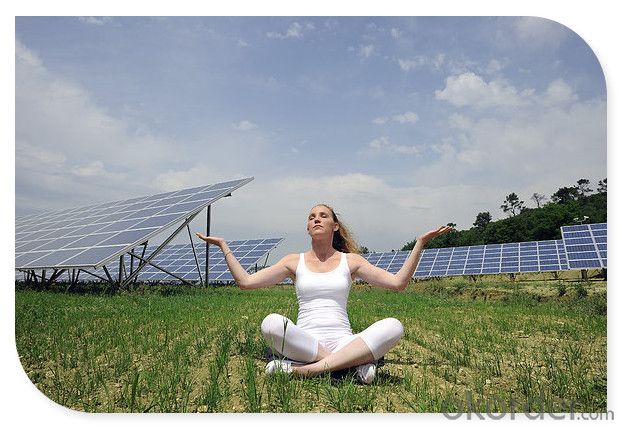
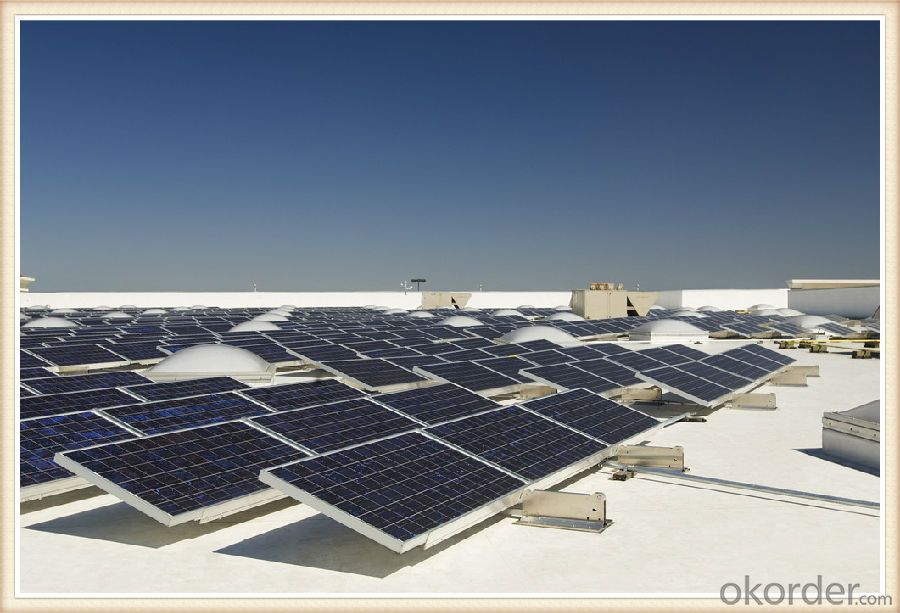
Solar Module Introduction
Solar modules use light energy (photons) from the sun to generate electricity through the photovoltaic effect. The majority of modules use wafer-based crystalline silicon cells or thin-film cells based on cadmium telluride or silicon. The structural (load carrying) member of a module can either be the top layer or the back layer. Cells must also be protected from mechanical damage and moisture. Most solar modules are rigid, but semi-flexible ones are available, based on thin-film cells. These early solar modules were first used in space in 1958.
Electrical connections are made in series to achieve a desired output voltage and/or in parallel to provide a desired current capability. The conducting wires that take the current off the modules may contain silver, copper or other non-magnetic conductive transition metals. The cells must be connected electrically to one another and to the rest of the system. Externally, popular terrestrial usage photovoltaic modules use MC3 (older) or MC4 connectors to facilitate easy weatherproof connections to the rest of the system.
Specification
Model Type | |
Peak Power-Pmax(W) | 5-200W |
Open Circuit Voltage-Voc(V) | 44.2 |
Maximum Power Voltage-Vmp(V) | 36 |
Short Circuit Current-Isc(A) | 5.4 |
Maximum Power Current-Imp(A) | 5 |
Maximum System Voltage | 1000V DC |
Maximum Series Fuse Rating | 10A |
Power Tolerance | -1~+3% |
Temperature Coefficients of Pmax | -0.45%/℃ |
Temperature Coefficients of Voc | -0.348%/℃ |
Temperature Coefficients of Isc | 0.031%/℃ |
Nominal Operating Cell Temperature | 44.5±2℃ |
Standard Testing Condition(STC) | Irradiance:1000W/m²;Temperature:25℃;AM=1.5 |
Qualification Test Parameters | |
Operating Temperature | -40℃~+85℃ |
Storage Temperature | -40℃~+85℃ |
Pressure Bearing | ≥5400Pascal/m² |
Wind Bearing | ≥5400Pascal/m² |
Mechanical Characteristics | |
Cell Size | Mono 125*125mm±0.5 |
No.of Cells | 72pcs(6*12) |
Dimension | 1580*808*40mm |
Weight | 15.5Kg |
Glass | 3.2mm High Transmission,Low Iron |
Frame | Anodized Aluminum Alloy |
Junction Box | IP65Rated |
Internal Diodes | 3 Bypass Diodes |
Cable | 1*4.0mm² Length 900mm |
Images
Packing & Shipping:
We have rich experience on how to pack the panels to make sure the safety on shipment when it arrives at the destination.
The normal size is packed by 25pcs/ carton / pallet. Paper carton for FCL shipping and wood carton for LCL shipping.
Features
1.High reliability with guaranteed -3% to +5% power output tolerance, ensuring return on investment
2.High conversion efficiency based on leading innovative photovoltaic technologies
3.Withstands high wind-pressure and snow load, and extreme temperature variations
4.Attractive appearanceUnique frame design, high mechanical strength, and easy Installation
Warranty:
For c-Si panel: 25years output warranty for no less than 80% of performance, 10 years output warranty for no less than 90% of performance. Free from material and workmanship defects within 5 years.
For a-Si panel: 20 years output warranty for no less than 80% of performance, 10 years output warranty for no less than 90% of performance. Free from material and workmanship defects within 2 years.
•100% product quality protection
•100% on-time shipment protection
•100% payment protection for your covered amount
FAQ:
(1)What price for each watt?
It depends on the quantity, delivery date and payment terms.
(2)What is your size for each module? Can you tell me the Parameter of your module?
We have different series of panels in different output, both c-Si and a-Si. Please take the specification sheet for your reference.
(3)Can you provide the peripheral products of the solar panels, such as the battery, controller, and inverter? If so, can you tell me how do they match each other?
Actually we are only manufacturer of solar panels, but we could try to source them for you in China if you need. We could provide you an optimal system design to instruct you how to install.
(4)Do you have the CE, TUV, UL Certification?
We’ve already passed all the tests, and any certificate is available.
(5)Have you ever sold your products to companies in my country?
Of course, we have customers in all general PV markets, but I think we should expand our market share along with the market growth.
(6)When did your company set up? You are a new company, how can I believe your quality?
We entered into Solar PV industry in 2005, now we have several plants in manufacturing of a-Si and c-Si panels, and our capacity is 220MW per year. Till now we have already passed all the tests by authorized laboratories, e.g. TUV, VDE, UL.
(7)Can you help us install the module if we cooperate with you?
We haven’t entered into installation sector, but we have the plan in near future.
(8) How do you pack your products?
We have rich experience on how to pack the panels to make sure the safety on shipment when it arrives at the destination.
(9) Can you do OEM for us?
Yes, we can.
(10)Can we visit your factory?
Surely, I will arrange the trip basing on your business schedule.
- Q:Can solar panels be installed on water pumps?
- Yes, solar panels can be installed on water pumps. Solar-powered water pumps are becoming increasingly popular and are a sustainable solution for providing water in remote areas or off-grid locations. These pumps use solar energy to power their operation, making them environmentally friendly and cost-effective in the long run.
- Q:They have been around long enough to be cheaper. Unless they are made out of a natural material that is rare and hard to find, there is no reason why they should be so expensive. On another note, I think that all low power devices like cell phones and even laptops should have solar panels. Even if it is not enough to fully power the device for a long period of time, it will provide some electricity savings and with millions of people saving a little power adds up.
- Photo okorder /... Notice it costs over $200 and it takes up a sizable amount of space. Plus you have to expose it to bright sun light. Over all this is not something the average consumer wants to spend money on or fuss with. If something is expensive, difficult or inconvenient to use then people won't use it. Just the basic economics of such a device limits its sales never mind its functionality and usability. Even if you made a small one buit into the cover to extend the battery you won't get much of an extension and you will increase the cost of your laptop. Consider how people shop, will they buy the more expensive laptop for a questionable amount of battery extension? Mass production can lower costs but in order to mass produce something you need a demand that will consume what you produce. But if no one wants the item because of the aforementioned issues than you can't justify mass producing the item. This is like the classic which came first Chicken or Egg problem, one doesn't happen without the other. Cost reduction doesn't happen without consumer demand. This is where tax incentives, subsidies, low cost loans and energy buyback contracts come into play in order to spur on demand and jump start mass production. You could also make electricity extremely expensive by taxing oil and carbon so that a Solar Cell becomes economically competitive to very expensive electricity. Problem with this option is the negative impact high energy costs have on economic activity. Just look at what happened a couple of summers ago when gas hit $4/gal. To spur on demand we need to incentives the use of Solar cells (and other alternative energy). This can be done through several means such as subsidies, tax incentives, low interest loans, energy buyback contracts etc...
- Q:How can solar panels be integrated into building designs?
- Solar panels can be integrated into building designs by incorporating them into the structure or facade of the building. This can be done by installing solar panels on the roof, as awnings, or as part of the building's walls or windows. Additionally, innovative designs like solar shingles or solar glass can also seamlessly integrate solar panels into the overall aesthetics of the building.
- Q:How do solar panels affect the overall resilience of a building?
- Solar panels can significantly enhance the overall resilience of a building. By generating clean and renewable energy, they reduce dependence on traditional power grids, making the building less vulnerable to power outages or disruptions. Additionally, solar panels can provide a reliable source of electricity during emergencies, ensuring critical systems like lighting or communication remain operational. The energy independence offered by solar panels enhances the building's ability to withstand and recover from various crises, ultimately improving its overall resilience.
- Q:Can solar panels be used to power a sports stadium?
- Yes, solar panels can be used to power a sports stadium. By installing a sufficient number of solar panels on the roof or surrounding areas of the stadium, the generated electricity can be used to power various facilities such as lighting, scoreboards, sound systems, and even some of the equipment needed for the sporting events. Additionally, excess energy can be stored in batteries or fed back into the grid, making it a sustainable and cost-effective solution for powering a sports stadium.
- Q:Plz also label the price for the panel. I want a small panel but can produce a sufficent amount of energy. thank you :)
- You might try Lowes Home Improvement. Or the yellow pages. Or Solar Panels R US.
- Q:Can solar panels be used to power a bank?
- Yes, solar panels can be used to power a bank. Solar panels generate electricity by converting sunlight into usable energy, which can be used to supply power to a bank's operations and facilities. By installing solar panels, banks can reduce their reliance on traditional energy sources and lower their carbon footprint. Additionally, solar power can help banks save on energy costs in the long run.
- Q:Are solar panels fire hazards?
- Solar panels themselves are not fire hazards. However, if there is a faulty installation, damage, or improper maintenance, there is a slight risk of fire. Regular inspections and adherence to safety guidelines greatly minimize this risk, making solar panels generally safe and reliable.
- Q:Can solar panels be used for charging electric scooters?
- Yes, solar panels can be used for charging electric scooters. The energy generated by the solar panels can be stored in batteries and then used to charge the electric scooter. This provides a sustainable and renewable energy source for powering electric scooters.
- Q:For a computer technology project we are using solar panels and trying to see different methods that will increase the output of solar power from these panels. For now, we have got polymer stickers and mirrors. Are there any more methods, or information that increase the solar power? Please and thank you :)
- If it's a solar heating panel, add insulation around it. If it's a solar electric panel, chill it in some manner, like with a fan, mist of water, etc. Electric panels are generally more efficient when cold.
1. Manufacturer Overview |
|
|---|---|
| Location | |
| Year Established | |
| Annual Output Value | |
| Main Markets | |
| Company Certifications | |
2. Manufacturer Certificates |
|
|---|---|
| a) Certification Name | |
| Range | |
| Reference | |
| Validity Period | |
3. Manufacturer Capability |
|
|---|---|
| a)Trade Capacity | |
| Nearest Port | |
| Export Percentage | |
| No.of Employees in Trade Department | |
| Language Spoken: | |
| b)Factory Information | |
| Factory Size: | |
| No. of Production Lines | |
| Contract Manufacturing | |
| Product Price Range | |
Send your message to us
20W Direct Factory Sale Price 260-300Watt Solar Panels
- Loading Port:
- China main port
- Payment Terms:
- TT OR LC
- Min Order Qty:
- 10000 watt
- Supply Capability:
- 100000 watt/month
OKorder Service Pledge
OKorder Financial Service
Similar products
New products
Hot products
